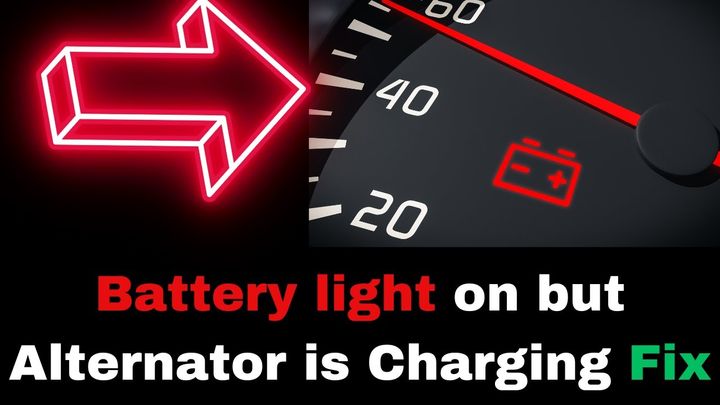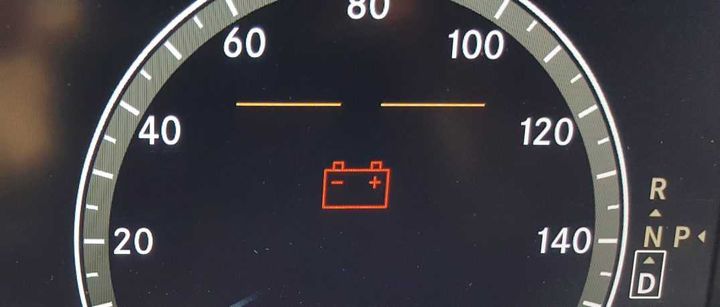


The battery light on your dashboard is an important indicator that should never be ignored. While it typically signals an issue with the charging system, the light can sometimes remain illuminated even when the alternator is functioning correctly. This can be puzzling and leave you unsure of the underlying cause. In this guide, we'll explore the various reasons why the battery light might stay on despite a good alternator and provide practical troubleshooting steps to resolve the issue.

The battery light, also known as the charging system warning light, alerts you to potential problems with the vehicle's electrical system. It is directly connected to the charging system, which includes the battery, alternator, voltage regulator, and associated wiring.
The alternator is a crucial component responsible for generating electrical power to recharge the battery and supply electricity to the vehicle's electrical components. When the engine is running, the alternator converts mechanical energy into electrical energy, ensuring the battery remains charged and the electrical systems function properly.
While a faulty alternator is a common reason for the battery light to illuminate, there are several other potential causes that can trigger the warning light even when the alternator itself is in good working condition. These include:
| Cause | Description |
|---|---|
| Loose or corroded battery connections | Prevent the alternator from properly charging the battery |
| Defective battery | May not hold a proper charge from the alternator |
| Wiring issues | Disrupt the flow of electrical current |
| Voltage regulator failure | Causes the alternator to overcharge or undercharge the battery |
| Excessive electrical loads | Strain the alternator, causing voltage fluctuations |
| Computer or sensor problems | Incorrectly detect charging system issues |
One of the first steps in troubleshooting is to inspect the battery terminals and cable connections for any signs of corrosion or looseness. Corroded or loose connections can prevent the alternator from properly charging the battery, causing the warning light to illuminate.
Visually inspect the battery terminals for corrosion (white or bluish-green crusty buildup).
Check for loose connections by gently wiggling the battery cables.
Clean corroded terminals using a wire brush or a specialized battery terminal cleaner.
Apply a thin layer of dielectric grease or battery terminal protector to prevent future corrosion.
Ensure that the battery cable connections are tight and secure.
If the battery connections are in good condition, the next step is to test the battery itself. A load test measures the battery's ability to deliver sufficient current to start the engine and power the electrical components.
Signs that a battery needs replacement:
Fails the load test
Approaching or exceeding its expected lifespan (typically 3-5 years)
Reduced capacity and inability to hold a proper charge
Replacing a defective battery can often resolve the issue of the battery light staying on, even with a good alternator.
Wiring issues and excessive electrical loads can also contribute to charging system faults and cause the battery light to remain illuminated.
Wiring Inspection:
Examine the wiring that connects the alternator to the battery and the vehicle's computer.
Look for signs of damage, fraying, chafing, or corrosion.
Identifying Excessive Electrical Loads:
Use a multimeter to measure the voltage at the battery terminals with all electrical components turned on.
If the voltage drops significantly, it may indicate an overloaded system.
Reducing Unnecessary Loads:
Turn off unnecessary electrical components or accessories to alleviate the strain on the alternator.
If the issue persists, further diagnosis and potential repairs may be required.
The voltage regulator controls the alternator's output voltage, ensuring it produces the correct voltage to charge the battery and power the electrical components without overcharging or undercharging the system.
Symptoms of Voltage Regulator Failure:
Battery light staying on
Dimming headlights
Electrical component malfunctions
Premature battery failure
If the voltage regulator is suspected to be the cause, it may need to be replaced. This can be a complex task, often recommended to be done by a professional mechanic or an authorized repair facility.
Modern vehicles are equipped with sophisticated computer systems that monitor various components and sensors, including the charging system. If the computer detects a problem, it can trigger the battery light and store diagnostic trouble codes (DTCs) in its memory.
Diagnosis Steps:
Scan the vehicle's computer system for stored DTCs using a specialized diagnostic tool.
Test the battery sensor, which measures the battery's voltage and temperature.
Perform a software update or reflash the computer system if a software-related issue is suspected.
While some troubleshooting steps can be performed by vehicle owners, it's important to recognize when professional assistance is required. Proper diagnosis is crucial when dealing with charging system issues and the battery light staying on.
Reasons to Seek Professional Assistance:
Checked battery connections, tested the battery, and inspected wiring and electrical loads, but the issue persists
Need access to specialized diagnostic tools and equipment
Complex charging system repairs or replacements required
Authorized repair facilities have trained technicians familiar with the specific electrical systems and components of your vehicle, ensuring repairs are performed correctly and with the proper parts and procedures.
To minimize the likelihood of charging system issues and the battery light staying on, regular preventive maintenance is essential.
Maintenance Tips:
Have your battery and charging system inspected periodically by a qualified mechanic.
Maintain clean and tight electrical connections to prevent corrosion and ensure proper electrical flow.
Avoid running too many power-hungry accessories or components simultaneously to prevent straining the charging system.
Troubleshooting a persistent battery light when the alternator appears to be functioning correctly can be challenging. However, by following a systematic approach and understanding the various potential causes, you can effectively diagnose and resolve the issue. Regular maintenance, proper diagnosis, and timely repairs are essential to ensure the reliability and longevity of your vehicle's charging system. If you encounter persistent issues, don't hesitate to seek professional assistance from a qualified mechanic or an authorized repair facility.
The battery light, also known as the charging system warning light, alerts you to potential problems with the vehicle's electrical system, specifically the charging system.
The alternator is responsible for generating electrical power to recharge the battery and supply electricity to the vehicle's electrical components when the engine is running.
Some potential causes include loose or corroded battery connections, a defective battery, wiring issues, voltage regulator failure, excessive electrical loads, and computer or sensor problems.
Visually inspect the battery terminals for corrosion and wiggle the battery cables to check for looseness. Clean corroded terminals and ensure tight connections.
Testing the battery's ability to hold a charge and deliver sufficient current can identify if a defective battery is causing the battery light to stay on.
Signs of voltage regulator failure include the battery light staying on, dimming headlights, electrical component malfunctions, and premature battery failure.
Scan the vehicle's computer system for diagnostic trouble codes, test the battery sensor, and perform software updates or reflashes if necessary.
Seek professional assistance if basic troubleshooting steps don't resolve the issue, if specialized diagnostic tools are needed, or if complex repairs or replacements are required.
Regular inspections, maintaining clean and tight electrical connections, and avoiding excessive electrical loads can help prevent charging system issues.
Proper diagnosis ensures the root cause is identified, and timely repairs prevent further damage and ensure the reliability and longevity of the charging system.

Miguel started tinkering with car radios as a teenager, fascinated by the intricate dance of wires and circuits. This passion led him to pursue a career as an automotive electrician. For the past 10 years, Miguel has tackled everything from flickering headlights to mysterious electrical gremlins. He thrives on troubleshooting electrical problems and enjoys sharing his knowledge to empower car owners to understand their vehicles better.



